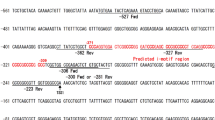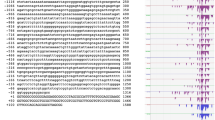Abstract
The trkA proto-oncogene encodes a high-affinity NGF receptor that is essential for the survival, differentiation and maintenance of many neural and non-neural cell types. Altered expression of the trkA gene or trkA receptor malfunction have been implicated in neurodegeneration, tumor progression and oncogenesis. We have cloned and characterized the 5′ region of the mouse trkA gene and have identified its promoter. trkA promoter sequences are GC-rich, lack genuine TATA or CAAT boxes, and are contained within a CpG island which extends over the entire first coding exon. The mouse trkA transcription start site is located 70/71 bp upstream to the AUG translation initiation codon. Sequence analysis showed that the gene encoding the insulin receptor-related receptor, IRR, is located just 1.6 kbp upstream to the trkA gene and is transcribed in the opposite direction. We have used trkA-CAT transcriptional fusions to study trkA promoter function in transient transfection experiments. RNase protection assays and CAT protein ELISA analyses showed that a 150 bp long DNA segment, immediately upstream to the start site, is sufficient to direct accurate transcription in trkA-expressing cells. Dissection of this fragment allowed us to identify a 13 bp cis-regulatory element essential for both promoter activity and cell-type specific expression. Deletion of this 13 bp segment as well as modification of its sequence by site-directed mutagenesis led to a dramatic decline in promoter activity. Gel mobility shift assays carried out with double-stranded oligonucleotides containing the 13 bp element revealed several specific DNA-protein complexes when nuclear extracts from trkA-expressing cells were used. Supershift experiments showed that the Sp1 transcription factor was a component of one of these complexes. Our results identify a minimal trkA gene promoter, located very close to the transcription start site, and define a 13 bp enhancer within this promoter sequence.
This is a preview of subscription content, access via your institution
Access options
Subscribe to this journal
Receive 50 print issues and online access
$259.00 per year
only $5.18 per issue
Buy this article
- Purchase on Springer Link
- Instant access to full article PDF
Prices may be subject to local taxes which are calculated during checkout





Similar content being viewed by others
References
Ausubel FM, Brent R, Kingston RE, Moore DD, Seidman JG, Smith JA and Struhl K. . 1995 Curr. Proto. in Mol. Biol. John Wiley and Sons, New York.
Barbacid M. . 1995 Curr. Opin. Cell Biol. 7: 148–155.
Bird AP. . 1986 Nature 321: 209–213.
Boissiere F, Faucheux B, Ruberg M, Agid Y and Hirsch EC. . 1997 Exp. Neurol. 145: 245–252.
Brodeur GM, Nakagawara A, Yamashiro DJ, Ikegaki N, Liu XG, Azar CG, Lee CP and Evans AE. . 1997 J. Neurooncol. 31: 49–55.
Clark SJ, Harrison J, Paul CL and Frommer M. . 1994 Nuc. Acids Res. 22: 2990–2997.
Chang BB, Persengiev SP, de Diego JG, Sacristan MP, Martin-Zanca D and Kilpatrick DL. . 1998 J. Biol. Chem. 273: 39–44.
Dalal R and Dajakiew D. . 1997 Mol. Cell Endocrinol. 134: 15–22.
Davies AM. . 1994 J. Neurobiol. 25: 1334–1348.
Ernfors P, Merlio JP and Persson H. Eur. . 1992 J. Neurosci. 4: 1140–1158.
Fagan AM, Zhang H, Landis S, Smeyne RJ, Silos-Santiago I and Barbacid M. . 1996 J. Neurosci. 16: 6208–6218.
Greco A, Miranda C, Pagliardini S, Fusetti L, Bongarzone I and Pierotti MA. . 1997 Genes Chrom. Cancer 19: 112–123.
Holtzman DM, Kilbridge J, Li Y, Cunningham Jr ET, Lenn NJ, Clary DO, Reichardt LF and Mobley WC. . 1995 J. Neurosci. 15: 1567–1576.
Indo Y, Tsuruta M, Hayashida Y, Karim MA, Ohta K, Kawano T, Mitsubuchi H, Tonoki H, Awaya Y and Matsuda Y. . 1996 Nat. Genet. 13: 485–488.
Kageyama R and Pastan I. . 1989 Cell 59: 815–825.
Lomen-Hoerth C and Shooter EM. . 1995 Neurochem. 64: 1780–1789.
Martin-Zanca D, Oskam R, Mitra G, Copeland T and Barbacid M. . 1989 Mol. Cell. Biol. 9: 24–33.
Martin-Zanca D, Hughes S and Barbacid M. . 1986 Nature 319: 743–748.
Martin-Zanca D, Barbacid M and Parada LF. . 1990 Genes Dev. 4: 683–694.
Mayerhofer A, Dissen GA, Parrott JA, Hill DF, Mayerhofer D, Garfield RE, Costa ME, Skinner MK and Ojeda SR. . 1996 Endocrinology 137: 5662–5670.
Mitchell PJ, Timmons PM, Hébert JM, Rigby WJ and Tjian R. . 1991 Genes Dev. 5: 105–119.
Miralles F, Philippe P, Czernichow P and Scharfmann R. . 1998 J. Endocrinol. 156: 431–439.
Parks CL and Shenk T. . 1996 J. Biol. Chem. 271: 4417–4430.
Reinhardt RR, Chin E, Zhang B, Roth RA and Bondy CA. . 1994 J. Neurosci. 14: 4674–4683.
Sambrook J, Fritsch EF and Maniatis T. . 1989 Cold Spring Harbor Laboratory Press, Cold Spring Harbor, New York.
Shier P and Watt VM. . 1992 Mol. Endocrinol. 6: 723–729.
Shier P, Willard HF and Watt VM. . 1990 Cytogenet. Cell Genet. 54: 80–81.
Tam SY, Tsai M, Yamaguchi M, Yano K, Butterfield JH and Galli SJ. . 1997 Blood 90: 1807–1820.
Torcia M, Bracci-Laudiero L, Lucibello M, Nencioni L, Labardi D, Rubartelli A, Cozzolino F, Aloe L and Garaci E. . 1996 Cell 85: 345–356.
Tsuji N, Tsujimoto K, Takada N, Ozaki K, Ohta M and Itoh N. . 1996 Brain Res. Mol. Brain Res. 41: 250–258.
Valent A, Danglot G and Bernheim A. . 1997 Eur. J. Hum. Genet. 5: 102–104.
Wheeler EF, Gong H, Grimes R, Benoit D and Vazquez L. . 1998 J. Comp. Neurol. 391: 407–428.
Yaar M, Eller MS, DiBenedetto P, Reenstra WR, Zhai S, McQuaid T, Archambault M and Gilchrest BA. . 1994 J. Clin. Invest. 94: 1550–1562.
Acknowledgements
We thank Dr F Antequera for valuable discussions and A Duwell for technical help. MP Sacristán and M Bonilla were recipients of postdoctoral and predoctoral fellowships from the Spanish Ministry for Education, respectively. This work was supported by grants from the Spanish Ministry for Education, DGICYT refs. PM91-0005 and PB94-1104, and by European Union Programs BMH2-CT96-0010 and BIO4-CT96-0285.
Author information
Authors and Affiliations
Rights and permissions
About this article
Cite this article
Sacristán, M., de Diego, J., Bonilla, M. et al. Molecular cloning and characterization of the 5′ region of the mouse trkA proto-oncogene. Oncogene 18, 5836–5842 (1999). https://doi.org/10.1038/sj.onc.1202963
Received:
Revised:
Accepted:
Published:
Issue Date:
DOI: https://doi.org/10.1038/sj.onc.1202963



